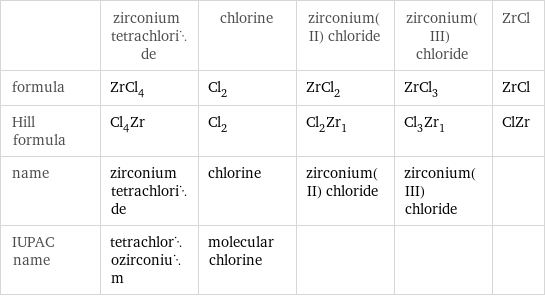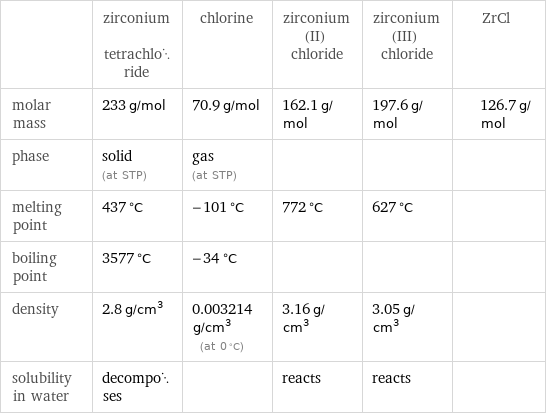Input interpretation

ZrCl_4 zirconium tetrachloride ⟶ Cl_2 chlorine + ZrCl_2 zirconium(II) chloride + ZrCl_3 zirconium(III) chloride + ZrCl
Balanced equation

Balance the chemical equation algebraically: ZrCl_4 ⟶ Cl_2 + ZrCl_2 + ZrCl_3 + ZrCl Add stoichiometric coefficients, c_i, to the reactants and products: c_1 ZrCl_4 ⟶ c_2 Cl_2 + c_3 ZrCl_2 + c_4 ZrCl_3 + c_5 ZrCl Set the number of atoms in the reactants equal to the number of atoms in the products for Cl and Zr: Cl: | 4 c_1 = 2 c_2 + 2 c_3 + 3 c_4 + c_5 Zr: | c_1 = c_3 + c_4 + c_5 Since the coefficients are relative quantities and underdetermined, choose a coefficient to set arbitrarily. To keep the coefficients small, the arbitrary value is ordinarily one. For instance, set c_3 = 1 and solve the system of equations for the remaining coefficients: c_3 = 1 c_4 = -1/2 + (3 c_1)/2 - c_2 c_5 = -1/2 - c_1/2 + c_2 The resulting system of equations is still underdetermined, so additional coefficients must be set arbitrarily. Set c_1 = 5 and c_2 = 5 and solve for the remaining coefficients: c_1 = 5 c_2 = 5 c_3 = 1 c_4 = 2 c_5 = 2 Substitute the coefficients into the chemical reaction to obtain the balanced equation: Answer: | | 5 ZrCl_4 ⟶ 5 Cl_2 + ZrCl_2 + 2 ZrCl_3 + 2 ZrCl
Structures

⟶ + + + ZrCl
Names

zirconium tetrachloride ⟶ chlorine + zirconium(II) chloride + zirconium(III) chloride + ZrCl
Equilibrium constant
![Construct the equilibrium constant, K, expression for: ZrCl_4 ⟶ Cl_2 + ZrCl_2 + ZrCl_3 + ZrCl Plan: • Balance the chemical equation. • Determine the stoichiometric numbers. • Assemble the activity expression for each chemical species. • Use the activity expressions to build the equilibrium constant expression. Write the balanced chemical equation: 5 ZrCl_4 ⟶ 5 Cl_2 + ZrCl_2 + 2 ZrCl_3 + 2 ZrCl Assign stoichiometric numbers, ν_i, using the stoichiometric coefficients, c_i, from the balanced chemical equation in the following manner: ν_i = -c_i for reactants and ν_i = c_i for products: chemical species | c_i | ν_i ZrCl_4 | 5 | -5 Cl_2 | 5 | 5 ZrCl_2 | 1 | 1 ZrCl_3 | 2 | 2 ZrCl | 2 | 2 Assemble the activity expressions accounting for the state of matter and ν_i: chemical species | c_i | ν_i | activity expression ZrCl_4 | 5 | -5 | ([ZrCl4])^(-5) Cl_2 | 5 | 5 | ([Cl2])^5 ZrCl_2 | 1 | 1 | [ZrCl2] ZrCl_3 | 2 | 2 | ([ZrCl3])^2 ZrCl | 2 | 2 | ([ZrCl])^2 The equilibrium constant symbol in the concentration basis is: K_c Mulitply the activity expressions to arrive at the K_c expression: Answer: | | K_c = ([ZrCl4])^(-5) ([Cl2])^5 [ZrCl2] ([ZrCl3])^2 ([ZrCl])^2 = (([Cl2])^5 [ZrCl2] ([ZrCl3])^2 ([ZrCl])^2)/([ZrCl4])^5](../image_source/4e537ea3cbd023e67286a0c7e0250b09.png)
Construct the equilibrium constant, K, expression for: ZrCl_4 ⟶ Cl_2 + ZrCl_2 + ZrCl_3 + ZrCl Plan: • Balance the chemical equation. • Determine the stoichiometric numbers. • Assemble the activity expression for each chemical species. • Use the activity expressions to build the equilibrium constant expression. Write the balanced chemical equation: 5 ZrCl_4 ⟶ 5 Cl_2 + ZrCl_2 + 2 ZrCl_3 + 2 ZrCl Assign stoichiometric numbers, ν_i, using the stoichiometric coefficients, c_i, from the balanced chemical equation in the following manner: ν_i = -c_i for reactants and ν_i = c_i for products: chemical species | c_i | ν_i ZrCl_4 | 5 | -5 Cl_2 | 5 | 5 ZrCl_2 | 1 | 1 ZrCl_3 | 2 | 2 ZrCl | 2 | 2 Assemble the activity expressions accounting for the state of matter and ν_i: chemical species | c_i | ν_i | activity expression ZrCl_4 | 5 | -5 | ([ZrCl4])^(-5) Cl_2 | 5 | 5 | ([Cl2])^5 ZrCl_2 | 1 | 1 | [ZrCl2] ZrCl_3 | 2 | 2 | ([ZrCl3])^2 ZrCl | 2 | 2 | ([ZrCl])^2 The equilibrium constant symbol in the concentration basis is: K_c Mulitply the activity expressions to arrive at the K_c expression: Answer: | | K_c = ([ZrCl4])^(-5) ([Cl2])^5 [ZrCl2] ([ZrCl3])^2 ([ZrCl])^2 = (([Cl2])^5 [ZrCl2] ([ZrCl3])^2 ([ZrCl])^2)/([ZrCl4])^5
Rate of reaction
![Construct the rate of reaction expression for: ZrCl_4 ⟶ Cl_2 + ZrCl_2 + ZrCl_3 + ZrCl Plan: • Balance the chemical equation. • Determine the stoichiometric numbers. • Assemble the rate term for each chemical species. • Write the rate of reaction expression. Write the balanced chemical equation: 5 ZrCl_4 ⟶ 5 Cl_2 + ZrCl_2 + 2 ZrCl_3 + 2 ZrCl Assign stoichiometric numbers, ν_i, using the stoichiometric coefficients, c_i, from the balanced chemical equation in the following manner: ν_i = -c_i for reactants and ν_i = c_i for products: chemical species | c_i | ν_i ZrCl_4 | 5 | -5 Cl_2 | 5 | 5 ZrCl_2 | 1 | 1 ZrCl_3 | 2 | 2 ZrCl | 2 | 2 The rate term for each chemical species, B_i, is 1/ν_i(Δ[B_i])/(Δt) where [B_i] is the amount concentration and t is time: chemical species | c_i | ν_i | rate term ZrCl_4 | 5 | -5 | -1/5 (Δ[ZrCl4])/(Δt) Cl_2 | 5 | 5 | 1/5 (Δ[Cl2])/(Δt) ZrCl_2 | 1 | 1 | (Δ[ZrCl2])/(Δt) ZrCl_3 | 2 | 2 | 1/2 (Δ[ZrCl3])/(Δt) ZrCl | 2 | 2 | 1/2 (Δ[ZrCl])/(Δt) (for infinitesimal rate of change, replace Δ with d) Set the rate terms equal to each other to arrive at the rate expression: Answer: | | rate = -1/5 (Δ[ZrCl4])/(Δt) = 1/5 (Δ[Cl2])/(Δt) = (Δ[ZrCl2])/(Δt) = 1/2 (Δ[ZrCl3])/(Δt) = 1/2 (Δ[ZrCl])/(Δt) (assuming constant volume and no accumulation of intermediates or side products)](../image_source/5f4776d94f22b1c701ef53033eea5375.png)
Construct the rate of reaction expression for: ZrCl_4 ⟶ Cl_2 + ZrCl_2 + ZrCl_3 + ZrCl Plan: • Balance the chemical equation. • Determine the stoichiometric numbers. • Assemble the rate term for each chemical species. • Write the rate of reaction expression. Write the balanced chemical equation: 5 ZrCl_4 ⟶ 5 Cl_2 + ZrCl_2 + 2 ZrCl_3 + 2 ZrCl Assign stoichiometric numbers, ν_i, using the stoichiometric coefficients, c_i, from the balanced chemical equation in the following manner: ν_i = -c_i for reactants and ν_i = c_i for products: chemical species | c_i | ν_i ZrCl_4 | 5 | -5 Cl_2 | 5 | 5 ZrCl_2 | 1 | 1 ZrCl_3 | 2 | 2 ZrCl | 2 | 2 The rate term for each chemical species, B_i, is 1/ν_i(Δ[B_i])/(Δt) where [B_i] is the amount concentration and t is time: chemical species | c_i | ν_i | rate term ZrCl_4 | 5 | -5 | -1/5 (Δ[ZrCl4])/(Δt) Cl_2 | 5 | 5 | 1/5 (Δ[Cl2])/(Δt) ZrCl_2 | 1 | 1 | (Δ[ZrCl2])/(Δt) ZrCl_3 | 2 | 2 | 1/2 (Δ[ZrCl3])/(Δt) ZrCl | 2 | 2 | 1/2 (Δ[ZrCl])/(Δt) (for infinitesimal rate of change, replace Δ with d) Set the rate terms equal to each other to arrive at the rate expression: Answer: | | rate = -1/5 (Δ[ZrCl4])/(Δt) = 1/5 (Δ[Cl2])/(Δt) = (Δ[ZrCl2])/(Δt) = 1/2 (Δ[ZrCl3])/(Δt) = 1/2 (Δ[ZrCl])/(Δt) (assuming constant volume and no accumulation of intermediates or side products)
Chemical names and formulas

| zirconium tetrachloride | chlorine | zirconium(II) chloride | zirconium(III) chloride | ZrCl formula | ZrCl_4 | Cl_2 | ZrCl_2 | ZrCl_3 | ZrCl Hill formula | Cl_4Zr | Cl_2 | Cl_2Zr_1 | Cl_3Zr_1 | ClZr name | zirconium tetrachloride | chlorine | zirconium(II) chloride | zirconium(III) chloride | IUPAC name | tetrachlorozirconium | molecular chlorine | | |
Substance properties

| zirconium tetrachloride | chlorine | zirconium(II) chloride | zirconium(III) chloride | ZrCl molar mass | 233 g/mol | 70.9 g/mol | 162.1 g/mol | 197.6 g/mol | 126.7 g/mol phase | solid (at STP) | gas (at STP) | | | melting point | 437 °C | -101 °C | 772 °C | 627 °C | boiling point | 3577 °C | -34 °C | | | density | 2.8 g/cm^3 | 0.003214 g/cm^3 (at 0 °C) | 3.16 g/cm^3 | 3.05 g/cm^3 | solubility in water | decomposes | | reacts | reacts |
Units
